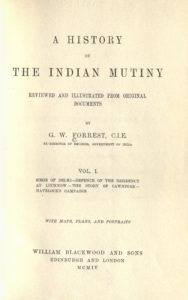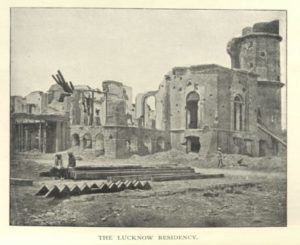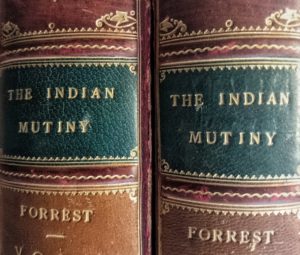 It cannot be denied that the Rebellion of 1857-8 was a turning point in Britain’s occupation of the Indian subcontinent. This is reflected in the prodigious literature produced on the subject, spanning novels, plays as well as works of historical scholarship. Even by the beginning of the 1860s a flurry of works on the Rebellion had been produced. Yet the subject of this post is George Forrest’s A history of the Indian Mutiny, published decades later, from 1904 to 1912.
It cannot be denied that the Rebellion of 1857-8 was a turning point in Britain’s occupation of the Indian subcontinent. This is reflected in the prodigious literature produced on the subject, spanning novels, plays as well as works of historical scholarship. Even by the beginning of the 1860s a flurry of works on the Rebellion had been produced. Yet the subject of this post is George Forrest’s A history of the Indian Mutiny, published decades later, from 1904 to 1912.
Although the work is dedicated to his father, Captain George Forrest (1803/4-1859) who would die as a result of the wounds he suffered in May 1857 defending and eventually destroying the Delhi magazine, the work bears little of the shock and at times anger of the literature produced during and in the immediate aftermath of the Rebellion. Perhaps this is understandable given the chronological distance between the Rebellion and the publication of Forrest’s account. What, then, are the features of Forrest’s narrative?
In his article on the historiography of the Rebellion the historian, S. N. Sen, stated that Forrest acknowledged the epic nature of his account but tried to offer a balanced view (Sen, S. N. ‘Writings of the Mutiny’ in Historians of India, Pakistan and Ceylon, p. 383) and this is something Forrest states explicitly declares in his introduction; although basing his account, ‘on the sure ground of official documents’, he recognises the potency which the events of 1857-8 wielded:
The Indian Mutiny addresses our mind through the intellect and the imagination. It is no mere memorable incident in Anglo-Indian history which conveys many grave lessons to those who labour in our Indian Empire, but it is a noble epic which speaks to every Englishman wherever he may be, and calls up past and glorious memories.
It must still be remembered, however, that Forrest’s narrative was a product of the high imperialism of the late Victorian and Edwardian periods. He acknowledges that various Indian communities did side with the British, depicting them as stoic – perhaps silently compliant – martyrs to Britain’s colonial interests

Photograph of the Lucknow Residency taken from Vol. 2 of Forrest’s The Indian Mutiny
There have been tongues and pens enough to narrate the excesses which have raised the Indian Mutiny to the rank of world-wide tragedy. It is useful that these crimes should be remembered and freshly pondered, but it is equally wise to study the opposite picture. The brave and turbulent population of Oudh with a few exceptions treated the fugitives of the ruling race with a marked kindness. Not only the loyalty and courage but also calm heroic spirit with which the sepoys in the Lucknow Residency endured dangers and trials are worthy of all honour. The devotion and fidelity of humble native attendants and loyal sepoys, the patient endurance and calm courage of our countrymen and countrywomen, the high energy and valour of the British soldier, afford some relief to the most terrible features of a tale of wrath and fury.
Turning away from this depiction, Forrest, when discussing the infamous catalyst for the Rebellion, the use of beef and pork grease in the manufacture of rifle cartridges, citing sources which depict the main enemy as persistent rumours, paying little attention to the fact that initially the fault lay with the British authorities, even though Colonel Richard Birch, military secretary, had ordered all cartridges issued were to be free from grease by the 27th January:
On the 24th January 1857, Major-General Hearsey, Commanding the Presidency Division, forwarded two letters for immediate submission to the Government of India. One of them was from Captain Wright…stating “that there appears to be a very unpleasant feeling existing among the native soldiers…regarding the grease used in preparing the cartridges, some evil-disposed persons having spread a report that it consists of a mixture of the fat of pigs and cows.”…Captain Wright also observed that some of the depot men in conversing with him on the subject had stated that “the report had spread throughout India, and when they went to their homes their friends would refuse to eat with them.
Forrest goes on to state
The propagator of sedition and the fanatic, the two great enemies of our rule, took advantage of the feeling of unrest and suspicion to raise the cry that a systematic attack was to be made on the ancient faith and customs of the people, and they pointed to the introduction of the greased cartridge as a proof of what they so sedulously preached.

This work can be found in the library at shelf-mark CLC.3131/For
This gives the briefest of glimpses into Forrest’s Rebellion and evidently his narrative is far from a sound depiction of the events of 1857-8. However this does not detract from its value. As a text loaded with the language of late nineteenth and early twentieth century British colonialism, it is fascinating in its own right, and is ultimately testament to the fractured nature of narrative and memory.
If you would like to find out more about our items on the Rebellion or our collection on Indian history, with its particular strength on the British period, search our catalogue here.
